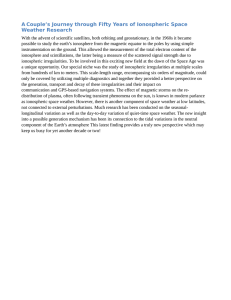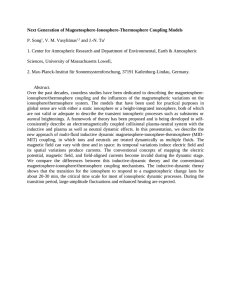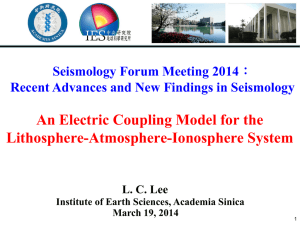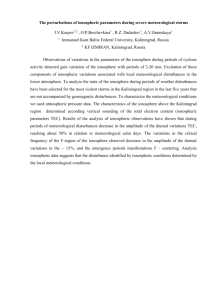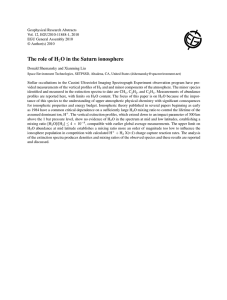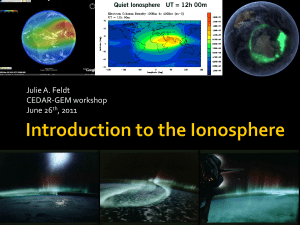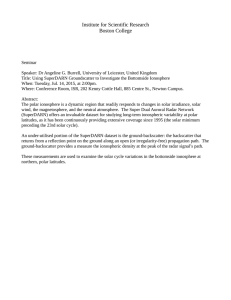Mathematical simulation of the large scale electric Valery Denisenko
advertisement
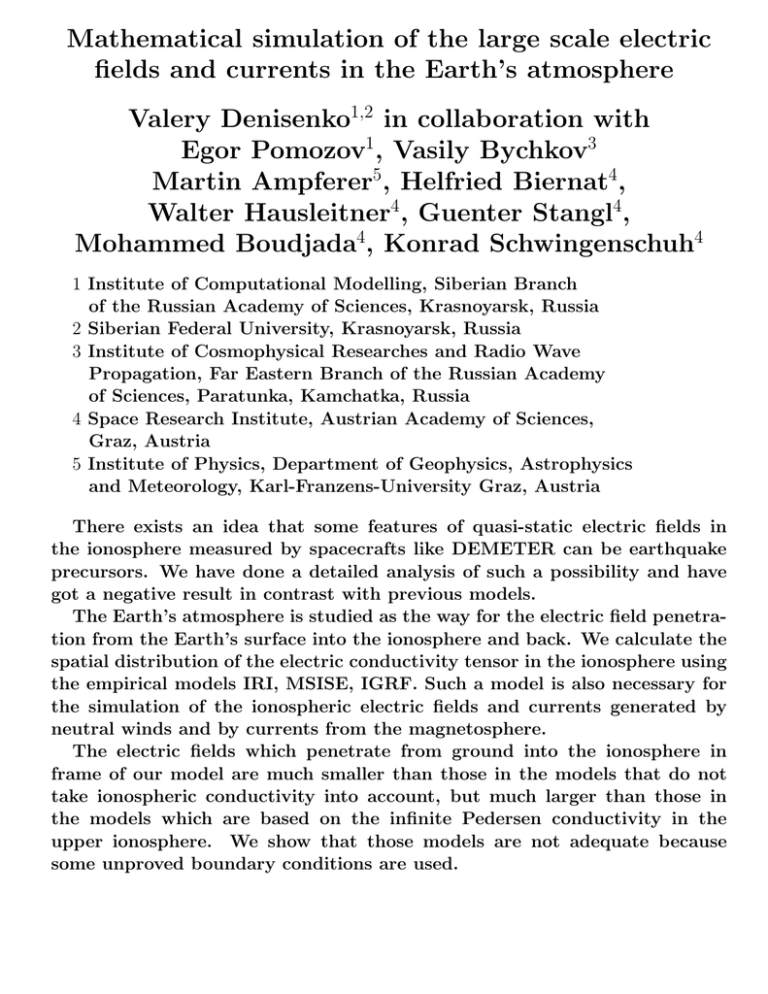
Mathematical simulation of the large scale electric fields and currents in the Earth’s atmosphere Valery Denisenko1,2 in collaboration with Egor Pomozov1, Vasily Bychkov3 Martin Ampferer5 , Helfried Biernat4, Walter Hausleitner4 , Guenter Stangl4, Mohammed Boudjada4, Konrad Schwingenschuh4 1 Institute of Computational Modelling, Siberian Branch of the Russian Academy of Sciences, Krasnoyarsk, Russia 2 Siberian Federal University, Krasnoyarsk, Russia 3 Institute of Cosmophysical Researches and Radio Wave Propagation, Far Eastern Branch of the Russian Academy of Sciences, Paratunka, Kamchatka, Russia 4 Space Research Institute, Austrian Academy of Sciences, Graz, Austria 5 Institute of Physics, Department of Geophysics, Astrophysics and Meteorology, Karl-Franzens-University Graz, Austria There exists an idea that some features of quasi-static electric fields in the ionosphere measured by spacecrafts like DEMETER can be earthquake precursors. We have done a detailed analysis of such a possibility and have got a negative result in contrast with previous models. The Earth’s atmosphere is studied as the way for the electric field penetration from the Earth’s surface into the ionosphere and back. We calculate the spatial distribution of the electric conductivity tensor in the ionosphere using the empirical models IRI, MSISE, IGRF. Such a model is also necessary for the simulation of the ionospheric electric fields and currents generated by neutral winds and by currents from the magnetosphere. The electric fields which penetrate from ground into the ionosphere in frame of our model are much smaller than those in the models that do not take ionospheric conductivity into account, but much larger than those in the models which are based on the infinite Pedersen conductivity in the upper ionosphere. We show that those models are not adequate because some unproved boundary conditions are used. The electric conductivity equation The electric conductivity equation for the electric potential V is −div (σ̂grad V ) = q, (1) where σ̂ - conductivity tensor, −q - divergence of extrinsic currents, if those exists. It is possible to neglect the Earth’s surface curvature for local events. We use Cartesian coordinates x, y, z with vertical z axis and z = 0 at ground. The problem is simplified much if the magnetic field is vertical and conductivity depends only of the height z, since in such a case Hall conductivity σH does not matter and the only Pedersen σP and field-aligned σk conductivities are involved in the equation 2 ∂ V ∂ 2V ∂ ∂V −σP (z) + − σk(z) = q. (2) ∂x2 ∂y 2 ∂z ∂z We have created the model Denisenko et al., 2008 a to calculate the components σP , σH , σk of the conductivity tensor σ̂ above 90 km, that is based on the empirical models IRI, MSISE, IGRF. We use the empirical model Molchanov, Hayakawa, 2008 below 60 km and smooth interpolation between 60 and 90 km. 500 z, km a b 400 300 200 100 σP σH σk 2 1 0 0 jx , A/m2 10−11 10−15 10−10 10−5 σ, S/m Figure 1: a – Typical height distributions of the conductivity tensor σ̂ components in middle latitudes. b – Height distributions of the horizontal current density, which are the result of our calculations and the models (Pulinets et al., 2003) (curve 1), Grimalsky et al., 2003 (curve 2). 2-D model of the ionospheric conductor Let us consider only the ionosphere below z < z∞ . For example the layer above 500 km adds less 1% to the integrated parameters of interest. The vertical current density can be given at this height ∂V σk(z∞ ) = j∞ (x, y), (3) ∂z z=z∞ or the currents in far conductors, which are connected with this boundary by magnetic field lines, can be taken into account as it is described below. We cut the upper ionosphere from the lower one by the plane z = zup and use the approximation σk = ∞ above z = zup . Hence the horizontal electric field components are independent of z and local Ohm law can be integrated over z to construct 2-D Ohm law with integral Pedersen and Hall conductivities ΣP , ΣH : Z z∞ Z z∞ Jx ΣP −ΣH Ex = , ΣP = σP dz ΣH = σH dz. (4) Jy ΣH ΣP Ey zup zup Such a simplified model permits to construct the boundary condition at z = zup: the currents, which enter this layer from below through the plane z = zup , and given currents (3), which enter this layer from above through the plane z = z∞ , are closed by the currents J in this layer Div J = jz |z=zup + Q. (5) When the events of interest have horizontal scale much less then the ionospheric scale that equals thousands kilometers in middle latitudes, the values of σP , σH are independent of x, y, and so ΣP , ΣH are constants. The constant ΣH can be omitted in (5) to obtain 2 ∂ V ∂ 2V ∂V −ΣP + + σk (zup) = Q. (6) ∂x2 ∂y 2 z=zup ∂z z=zup The possibility to represent the ionospheric influence on the electric fields below z = z∞ by this boundary condition is tested by comparison of the solutions of the problem with this condition and the solutions in the whole ionosphere and atmosphere below z = z∞ . ELECTRIC FIELD PENETRATION FROM GROUND TO THE IONOSPHERE The vertical component of the electric field at the ground is taken as given in many models ∂V = E0 (x, y), (7) − ∂z z=0 and we do the same. The function E0(x, y) is constructed on the base of published measurements and some general ideas. It would be better to say about vertical current density that is supported by some underground generator. Since conductivity of air is given, these conditions are equivalent. We choose z∞ = 500 km and the solutions of the form f (z) cos (x/x0), where x0 is the horizontal space scale. The equation (2) becomes the ordinary differential equation for the function f (z). The boundary value problems with conditions which follow (7, 6) or (7, 3) can be solved numerically. We solve the problems with x0 = 100 km, Ez (0, 0) = 100 V/m.. The height distributions of the horizontal component of the electric field Ex (πx0/2, z) above the point x = πx0 /2, where it has maximal value. 150 z, km 100 80 60 40 20 0 10−10 10−6 Ex , V/m 1 Height distributions of the horizontal component of the electric field in the night-time ionosphere for x0 = 100 km. Bold line - our model. Dashed line - model (Pulinets et al., 2003). Thin line - model (Grimalsky et al., 2003). Figure 2: The height zup = 90 km as it was done in the models Denisenko et al., 2008, Ampferer et al., 2010 adds only 1% error to the ionospheric value of Ex if x0 exceeds 3 km. The solution with boundary condition that is used in the model Pulinets et al., 2003, ∂V = 0, (8) ∂z z=90 is plotted by dashed line. Thin line corresponds to the boundary condition Grimalsky et al., 2003 V |z=150 = 0. (9) The last would be valid if an ideal conductivity in horizontal directions exists above 150 km. The condition (8) means no vertical current from the atmosphere at 90 km. It would be valid if the medium above 90 km has zero conductivity at least in horizontal directions. The conditions (8, 9) can be derived from ours (6) when ΣP equals zero or infinity. As it is shown in Fig. 2 the neglecting the ionospheric conductivity (8) increases ionospheric Ex about thousand times. The approximation ΣP = ∞ decreases Ex a few thousands times at z = 100 km and makes it exactly zero above 150 km. It can be mentioned that if we add conductivity of the adjoint ionosphere, that means twice larger ΣP , then Ex in the ionosphere would be twice less. If a process in the auroral zone is under analysis then the conductivity of the plasma layer ΣP about 100 S aught be added and Ex becomes 140 times less. Nevertheless it stays much larger than in the model Grimalsky et al., 2003. If we take into account the decrease of the effective σP , that describes the ionospheric conductor after its 1 hour acceleration by Ampere force Ex would be 2.5 times larger, but it stays much less than Ex in Pulinets et al., 2003. If the magnetic field B is inclined from vertical by the angle χ, the tensor Σ̂ aught be modified. In our test problem the parameter ΣP in the upper boundary condition (6) aught be substituted with ΣP / cos (χ) or ΣP / cos2 (χ) when B is in y, z or x, z planes. Therefore the result Ex in the ionosphere decreases in comparison with those presented in Fig. 2a by the factor cos (χ) or cos2 (χ). Some more complicated model than (5) is necessary for the equatorial ionosphere Denisenko et al., 2008 a. Extrinsic currents The the model (Sorokin et al., 2006, 2001) differs from three models analyzed above by inclusion of extrinsic currents. The authors suppose that the vertical extrinsic current exists due to the diffusion of charged particles of aerosol. In their estimations these particles density equals to N+ = 4 · 109/m3 near ground, the current density decreases with height, the value near ground is js = 3 · 10−9A/m2, and the decrement equals 1/H = 1/(2 km). Since the charge of each particle is supposed to be equal to the electron charge e, one can calculate the flux density as js /e. It is proportional to the density gradient because it is due to diffusion js ∂N+ =K , (10) e ∂z where K is the coefficient of vertical turbulent diffusion in the near ground atmosphere. If we suppose that the decrease of this current with height corresponds to decreasing of the charged aerosol particles concentration, then gradient approximately equals N+ /H. Using (10) we can estimate K = js H/(eN+) = 104m2 /sec, that is thousands times larger than it is possible in the Earths atmosphere. It is also important that this extrinsic current exists as the transfer of uncompensated charges. If a charge is placed into a conducting medium, it is compensated with charges of other sign by conductivity current after typical time ε0 /σ < 10 minutes, since usually σ exceeds 2 · 10−14S/m. Then movement of neutral air means zero total current. So such an extrinsic current can not exist as a quasi stationary one even in a very turbulent atmosphere. Conductivity variations Fare weather currents can be disturbed if conductivity near ground is varied Harrison et al., 2010. If radon concentration increases 10 times then conductivity increases 3 times and decreases 3 times. If 0.25 mkm diameter aerosol concentration increases 10 times then conductivity decreases 4 times and increases 4 times. So δEz near ground +70 V/m or -400 V/m could be observed with negligible variations in the ionosphere. The ionospheric result Harrison et al., 2010 appear since the vertical velocity of D layer equals to the variation of the current velocity of the electrons, that is not obvious. Also, if horizontal scale is less than 100 km, 1-D approach becomes not adequate and current density in the ionosphere decreases. Conclusions on THE ELECTRIC FIELD PENETRATION TO THE IONOSPHERE The new mathematical model is proposed to represent the ionospheric conductor by the boundary condition. This approximation is rather precise for large scale processes. It is shown that two popular models of the electric field penetration into the ionosphere Pulinets et al., 2003, Grimalsky et al., 2003 are not adequate in spite of that they give good results below 50 and 80 km respectively. Unproved upper boundary conditions are used in these models. In fact the good ionospheric conductor is excluded in Pulinets et al., 2003 and unreal good conductor is added in Grimalsky et al., 2003. That is why our models Denisenko et al., 2008, Ampferer et al., 2010 predict ionospheric electric fields not so large as the model Pulinets et al., 2003 does, and not so small as the model Grimalsky et al., 2003 does. Other physical processes but electric conductivity of the atmosphere aught be analyzed to explain earthquake precursors in the ionosphere. Bibliography Ampferer M., V.V. Denisenko, W. Hausleitner, S. Krauss, G. Stangl, M.Y. Boudjada, and H.K. Biernat, (2010), Decrease of the electric field penetration into the ionosphere due to low conductivity at the near ground atmospheric layer. Annales Geophysicae, 28, No. 3, 779-787. Denisenko V.V., H.K. Biernat, A.V. Mezentsev, V.A. Shaidurov, and S.S. Zamay, (2008a), Modification of conductivity due to acceleration of the ionospheric medium, Annales Geophysicae, 26, 2111-2130. Denisenko V.V., M.Y. Boudjada, M. Horn, E.V. Pomozov, H.K. Biernat, K. Schwingenschuh, H. Lammer, G. Prattes, and E. Cristea (2008b), Ionospheric conductivity effects on electrostatic field penetration into the ionosphere, Natural Hazards and Earth System Sciences Journal, 8, 1009-1017. Denisenko V.V., V.V. Bychkov, and E.V. Pomozov, (2009), Calculation of Atmospheric Electric Fields Penetrating from the Ionosphere, Geomagnetism and Aeronomy, 49, No. 8, 1275-1277. Grimalsky V.V., M. Hayakawa, V.N. Ivchenko, Yu.G. Rapoport, and V.I. Zadorozhnii, (2003), Penetration of an electrostatic field from the lithosphere into the ionosphere and its effect on the D-region before earthquakes, Journal of Atmospheric and Solar-Terrestrial Physics, 65, 391-407. Harrison R.G., K.L. Aplin, and M.J. Rycroft, (2010), Atmospheric electricity coupling between earthquake regions and the ionosphere, Journal of Atmospheric and Solar-Terrestrial Physics, 72, 376-381. Molchanov O. and M. Hayakawa, (2008), Seismo-electromagnetics and related phenomena: History and latest results. 190 pp., TERRAPUB, Tokyo. Pulinets S.A., A.D. Legen’ka, T.V. Gaivoronskaya, and V.Kh. Depuev, (2003), Main phenomenological features of ionospheric precursors of strong Earthquakes, Journal of Atmospheric and Solar-Terrestrial Physics, 65, 13371347. Sorokin V.M., V.M. Chmyrev, A.K. Yaschenko. (2001), Electrodynamic model of the lower atmosphere and the ionosphere coupling. Journal of Atmospheric and Solar-Terrestrial Physics, 63, 1681-1691. Sorokin V.M., V.M. Chmyrev, A.K. Yaschenko. (2006) Possible DC electric field in the ionosphere related to seismicity. Advances in Space Research, 37, 666-670. ELECTRIC FIELD PENETRATION FROM THE IONOSPHERE TO THE NEAR GROUND ATMOSPHERE R Minimum of the energy functional W (V ) = σ(grad V )2 dΩ. 3-D multirgid finite element method and proper software are created. a dV = 5kV b a - Quiet time potential in the ionosphere, δθ = 10o between the circles. b - Vertical cross-section 0 < h < 80km through the points with max and min values of V . Figure 3: If the potential difference in the ionosphere equals ±30 kV, the vertical electric field near ground is about Er = ±13 V/m. It can be calculated in frame of 1-D model if horizontal scale exceeds 100 km. 3-D model must be used for calculation of the electric field in the upper ionosphere.
